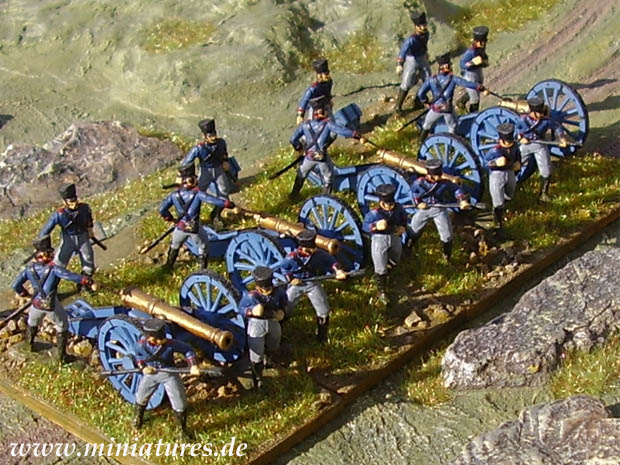Parisian or Prussian Blue
Historical Paint for Miniatures

Prussian Artillery of the 1813–1814 Wars of Liberation, wearing the typical dark blue uniforms from which the name Preußisch Blau derived. Prussian Blue is a very dark blue, colourfast, non-toxic, synthetic pigment which was discovered accidentally by Berlin colour maker H. Diesbach in 1704. Diesbach produced red dye from cochineal scale insects (Dactylopius coccus). One day, when Diesbach’s supply of potash had run out, he borrowed left-over potash lye from his fellow chemist Johann Conrad Dippel, which Dippel had distilled from essential animal oils (Oleum Animale). When Diesbach added the potash lye to his concoction, the colour unexpectedly turned blue. He reported the incident to Dippel, who improved the recipy and immediately recognized the market potential of their discovery. Dippel and Diesbach moved to Paris together and produced their Berliner Blue under the name of Parisian Blue. They kept their recipy a trade secret for a some time, but in 1724 the formula became known, and English chemists started producing the synthetic dye under the name of Prussian Blue.
Prior to the introduction of synthetic pigments, fabric was dyed blue with woad (Isatis tinctoria L.). From the 13th to 16th century, the woad plant was a source of great wealth for Thuringian woad farmers, dyers, weavers, and fabric makers. Woad leaves were crushed in woad mills and fermeted with human urin for two weaks. It was eventually discovered that the addition of alcohol created an even stronger blue. Alcohol was expensive at the time, and the dyers’ apprentices preferred to drink the alcohol themselves, to add their alcoholic urin to the fermentation vats later. Even today, the German term "Blau machen", literally making blue, refers to a form of absenteeism on blue mondays, typically caused by excessive drinking or partying.
Thuringian woad production declined in the late 16th and early 17th century, when chemically identical, but much cheaper indigo was imported from India. In addition, the Thirty Years’ War hampered European trade. To protect the woad industry, the use of indigo was punished by law for some time, but indigo prevailed. Of the more than 300 Thuringian villages, which had produced woad powder, there were only three near Erfurt and twelve near Gotha still engaged in this business by 1747.
Hans Bleckwenn writes in his series of paperbacks on the uniforms of the Prussian army of the Seven Years’ War that "dark blue had always been a popular uniform colour in Brandenburg-Prussia", and he goes on to say that "it is difficult to determine if woad was still used and when indigo was introduced to dye the fabric; officer’s uniforms were probably dyed with indigo, and a variety of dyes may have been used for the uniforms of the enlisted men".
Thuringian woad production flourished again briefly during the 1806 to 1813 Continental System imposed by Napoleon. The last woad factory at Neudietendorf was closed down in 1821; it resumed production in 1980 purely for the purpose of historic and scientific research. Indian indigo lost its market in 1897 to synthetic indigo manufactured by Badische Anilin und Sodafabrik (BASF). Chemist Adolf von Baeyer had begun synthesizing indigo in 1865, and he received a patent for the process 15 years later, on 19 March 1880.
Blue Fabric, blue Uniforms
The history of the blue dye has important implications for the miniatures hobby. Because of the variable quality of the blue dye, figure painters may use a variety of shades of blue even within the same "uniformed" regiment. Fabric dyed with woad or indigo would differ from batch to batch, and it would fade quickly, because woad and indigo dyes are not colourfast. The Museum at Festung Sonnenberg in Saxony had a Prussian Seven Years’ War grenadier uniform on display which had faded to a light blue colour of old stone-washed jeans.
Bavarian uniforms of the Seven Years’ War are reported to have been confusingly similar to enemy Prussian uniforms. By conjecture, Bavarian uniforms are assumed to have been dark blue, ignoring the fact that Prussian uniforms may have faded to a medium blue which could indeed be confused with Bavarian cornflower blue uniforms.
- Blue fabric dyed with woad from the 13th to 16th century
- Blue fabric dyed with woad or indigo from the 16th to 18th century
- Blue fabric dyed with woad, indigo, or Parisian Blue from 1704
It is not known if and when blue uniforms of the French army, like those of the Grenadiers de France, were dyed with Parisian Blue. - Blue uniforms dyed with woad, indigo, Parisian or Prussian Blue from 1724
It is not known if Prussian Blue was used to dye fabric for Prussian uniforms of the Seven Years’ War and, if it was used, which market share the new pigment had in Prussia. - Blue fabric dyed with woad from 1806 to 1813
- Thuringian woad production ceased in 1821
By the mid 19th century synthetic Prussian Blue and colonial plant indigo was used to dye fabric for Prussian uniforms. - Synthetic indigo from BASF was used exclusively from 1897
Officers preferred tailor-made uniforms of superior quality, which would not fade as quickly as the mass-produced uniforms worn by enlisted men. Prussian soldiers received a new uniform coat every year, and they must have been relatively uniformely dressed in dark blue, at least in times of peace. Figure painters need to mix their Prussian Blue with approximately 30 percent white, to take aerial perspective into account. Artist colours with valuable indigo, Parisian Blue, or Prussian Blue pigment are available at art stores.